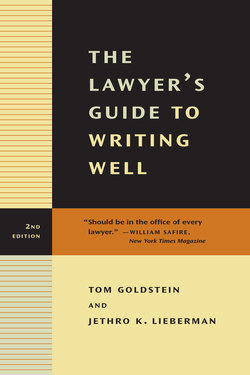Читать книгу The Lawyer's Guide to Writing Well - Tom Goldstein - Страница 6
На сайте Литреса книга снята с продажи.
ОглавлениеPREFACE
The first edition of this book was written in 1988, at a time when many critics were bemoaning the state of legal writing but few were doing anything about it. Between October 1987 and June 1988, we asked 650 people familiar with legal writing—practicing lawyers, judges, professors, writing instructors, and journalists who report on legal topics— what bothered them most about the way lawyers write. We do not pretend that our survey was scientific: We sent a four-page questionnaire to people listed on our Rolodexes. As journalists we had covered law and the legal profession since the early 1970s for a variety of news media, and our list included thoughtful lawyers and writers in half the states and every major city; most major law firms, scores of smaller firms, and courts; law schools; and newspapers, magazines, and broadcast stations across the country. The answers from 300 respondents inform a portion of this book. People named in the text but not identified in the notes were respondents and are identified in the acknowledgments. Unattributed statements about what lawyers, judges, professors, writing instructors, and journalists “think,” “feel,” or “believe” are drawn from the statements of these respondents, as are some of the displayed quotations.
In the dozen years since the first edition appeared, there have been vast changes in the technology of communications—the ways in which lawyers produce and distribute their letters, memoranda, briefs, and other documents. In the late 1980s, desktop computers were beginning to find their way into lawyers' offices, but probably few lawyers used them regularly or proficiently. (Indeed, lawyers at some firms told us they were forbidden to touch a computer; managing partners in those days viewed the “word processor” as a tool for secretaries and typists, not professionals.) By today's standards, early desktop computers were clunky machines, though surely useful and already then revolutionizing the production of legal paper. Although laser printers became available, few offices had hooked them to their computers or were realizing their potential to supplant the print shops to which at least the more formal of their documents continued to be sent. The desktops of the 1980s were only beginning to be networked; e-mail was scarce or nonexistent; lawyers were untrained in computerized legal research; and no one in the legal world had then heard of the Internet.
For all of the rapid improvement in communications technology since 1988, legal writing has improved little, if at all. Law offices around the country, busier than ever, have largely defaulted in training their newcomers. The large law firms hired so many new associates during the 1990s that they found it impossible to provide the one-on-one training in writing and editing that had been customary until sometime in the 1960s. Government legal offices and smaller firms have little time and few resources to devote to the task. Their response to poor writing by their young lawyers is to blame the law schools.
The law schools, of course, would assign the blame elsewhere. During the 1990s most American law schools established (or beefed up) their legal writing programs, usually a yearlong course in writing and research. These programs and courses were spurred by the “MacCrate Report” of the American Bar Association in 1992.1 Named after its chairman, New York lawyer Robert MacCrate, the Task Force on Law Schools and the Profession called on the law schools to add communication skills to their educational objectives. The cry for greater clarity in communication, however, has not led to serious curricular reform. Most law school classroom instruction remains oral, and full-time professors devote almost no time to critiquing their students' written work. Even in legal writing courses, writing often takes a back seat to legal analysis, research, and the formats for motions, briefs, and other legal documents. For all the talk about legal literacy, writing instructors have the lowest prestige and the smallest claim on the resources of the law schools in which they work. The consequence is that the law schools remain unequipped to deal with a generation of increasingly ill prepared college graduates who clamor for admission.
Our hearts sank when we read in the Columbia law school newspaper in 2001 about a well-meaning but flawed effort to educate Columbia law students about writing. Professor H. Richard Uviller, a published author of nonfiction intended for a broad audience, did what no other Columbia law professor had ever done—offered a course on basic writing. “I call this the tenth-grade English class that you never took,” Uviller told the newspaper. “It's a class in basic grammar, syntax, style and usage.”2 Remarkably, 160 students—just under half the first-year class—enrolled for this noncredit course. They were divided into two sections, an impossibly high number of students. Writing needs to be taught in small sections, preferably no more than 15. In this course, no papers were required—surely an odd way to learn a skill for which practice is obligatory.
Nearly fifteen years after we began the first edition of this book, lawyers still write poorly.
